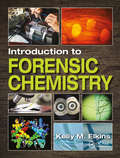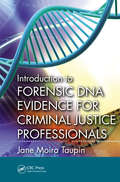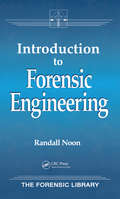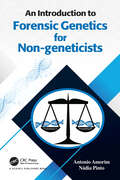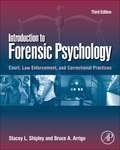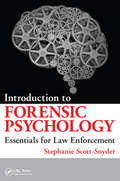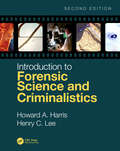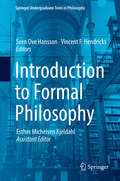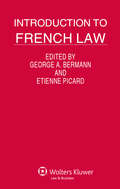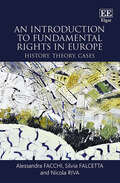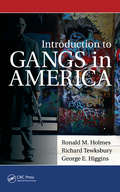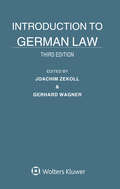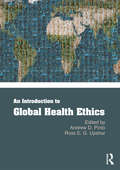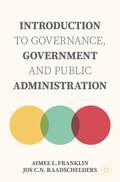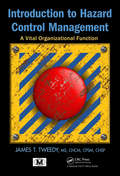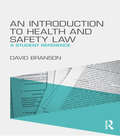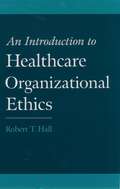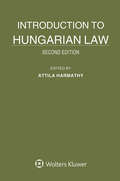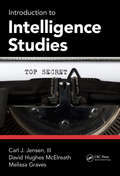- Table View
- List View
Introduction to Forensic Chemistry
by Kelly M. ElkinsChemistry/Forensic Science Forensic chemistry is a subdiscipline of forensic science, its principles guide the analyses performed in modern forensic laboratories. Forensic chemistry’s roots lie in medico-legal investigation, toxicology and microscopy and have since led the development of modern forensic analytic techniques and practices for use in a variety of applications. Introduction to Forensic Chemistry is the perfect balance of testing methods and application. Unlike other competing books on the market, coverage is neither too simplistic, nor overly advanced making the book ideal for use in both undergraduate and graduate courses. The book introduces chemical tests, spectroscopy, advanced spectroscopy, and chromatography to students. The second half of the book addresses applications and methods to analyze and interpret controlled substances, trace evidence, questioned documents, firearms, explosives, environmental contaminants, toxins, and other topics. The book looks at innovations in the field over time including the latest development of new discernible chemical reactions, instrumental tools, methods, and more. Key features: Nearly 300 full-color figures illustrating key concepts and over 20 case studies Addresses all the essential topics without extraneous or overly advanced coverage Includes full pedagogy of chapter objectives, key terms, lab problems, end of chapter questions, and additional readings to emphasize key learning points Includes chemical structures and useful spectra as examples Fulfils the forensic chemistry course requirement in FEPAC-accredited programs Includes a chapter on Chemical, Biological, Radiological, Nuclear, and Explosive (CBRNE) materials Comprehensive and accessible, without being overly technical, Introduction to Forensic Chemistry will be a welcome addition to the field and an ideal text designed for both the student user and professor in mind. Course ancillaries including an Instructor’s Manual with Test Bank and chapter PowerPoint® lecture slides are available with qualified course adoption.
Introduction to Forensic DNA Evidence for Criminal Justice Professionals
by Jane Moira TaupinThe use of DNA profiling in forensic cases has been considered the most innovative technique in forensic science since fingerprinting, yet for those with limited scientific knowledge, understanding DNA enough to utilize it properly can be a daunting task. Introduction to Forensic DNA Evidence for Criminal Justice Professionals is designed for nonsc
Introduction to Forensic Engineering
by Randall K. NoonForensic engineering is generally defined as the application of engineering principles and methodology to answer questions of fact that may have legal ramifications. This new book provides an introduction to the science, methodology, and engineering principles involved in the diagnosis of some common types of accidents and failures, such as fires, explosions, automobile accidents, storm damage, industrial accidents, slips and falls, arson, water pipe damage and more. Each chapter stands alone and can be read without reference to the others. The chapters have been written so that non-technical professionals can easily digest the information and immediately apply it. The book will also be useful to technical professionals who are unfamiliar with particular investigative methodology or technical points of interest. Introduction to Forensic Engineering will benefit lawyers, insurance investigators, engineers, and other professionals who must handle investigative and legal aspects of accidents or failures.
Introduction to Forensic Engineering
by Randall K. NoonForensic engineering is generally defined as the application of engineering principles and methodology to answer questions of fact that may have legal ramifications. This new book provides an introduction to the science, methodology, and engineering principles involved in the diagnosis of some common types of accidents and failures, such as fires, explosions, automobile accidents, storm damage, industrial accidents, slips and falls, arson, water pipe damage and more. Each chapter stands alone and can be read without reference to the others. The chapters have been written so that non-technical professionals can easily digest the information and immediately apply it. The book will also be useful to technical professionals who are unfamiliar with particular investigative methodology or technical points of interest. Introduction to Forensic Engineering will benefit lawyers, insurance investigators, engineers, and other professionals who must handle investigative and legal aspects of accidents or failures.
An Introduction to Forensic Genetics for Non-geneticists
by Antonio Amorim Nádia PintoThis book aims to enable non-experts in Genetics to understand the contribution of this science to resolve civil or criminal litigations, analysing evidence of human and non-human origins. The main difficulties in the comprehension and misuse of the results of Forensic Genetics reside in the lack of effective communication between geneticists and the users of the produced information (as lawyers and judges) and do not arise primarily from the lack of knowledge of genetics. Therefore, instead of a classical handbook we use a question-and-answer approach, which meets this interfacial essence. Questions that can be addressed by genetic expertise are typified and for each of them we provide the possible expert report, presenting the essential biological and statistical genetics background in the form of boxes/appendices, along with exemplary cases. Legal, ethical, and theoretical limitations of Forensic Genetics are discussed, formulating questions that cannot, or should not, be addressed by this applied science.
An Introduction to Forensic Genetics for Non-geneticists
by Antonio Amorim Nádia PintoThis book aims to enable non-experts in Genetics to understand the contribution of this science to resolve civil or criminal litigations, analysing evidence of human and non-human origins. The main difficulties in the comprehension and misuse of the results of Forensic Genetics reside in the lack of effective communication between geneticists and the users of the produced information (as lawyers and judges) and do not arise primarily from the lack of knowledge of genetics. Therefore, instead of a classical handbook we use a question-and-answer approach, which meets this interfacial essence. Questions that can be addressed by genetic expertise are typified and for each of them we provide the possible expert report, presenting the essential biological and statistical genetics background in the form of boxes/appendices, along with exemplary cases. Legal, ethical, and theoretical limitations of Forensic Genetics are discussed, formulating questions that cannot, or should not, be addressed by this applied science.
Introduction to Forensic Psychology: Court, Law Enforcement, and Correctional Practices
by Bruce A. Arrigo Stacey L. ShipleyIntroduction to Forensic Psychology, Third Edition, has been completely restructured to explain in greater detail how courses on forensic psychology are taught, making it more applicable as a textbook than previous editions. It also features more figures, tables and text boxes, making it a true textbook. What this book has that others do not is equal representation of criminal behavior, the court systems, and law enforcement/prisons. It also has equal representation of criminal and civil forensics. Other texts tend to be weighted towards just criminal behavior or just criminal justice and primarily criminal or civic forensics but not both. This new edition also has equal representation of issues to pertaining to adults and children. It contains new coverage of cyberbullying, tests and assessments in the courtroom, mental deficiency and competency to stand trial, and information on mothers who kill their children. Adult, juvenile and family issues are dealt with separately, making it easier to find what you need. Case illustrations dramatically highlight how the lives of individuals have been (or could be) impacted by developments in psychology and law. Chapters now include pedagogy, including outlines, main points, and relevant websites. This book is intended for professors teaching introduction to forensic psychology, as well as for students interested in adult, child, and family forensics as they apply to criminal and civic forensics law enforcement/prisons. Newly structured to map closer to how this information is taught and learnedComprehensive coverage ensures inclusion of criminal and civic forensics as well as police and law enforcementChapters now include pedagogy, including outlines, main points, and relevant websites
Introduction to Forensic Psychology: Essentials for Law Enforcement
by Stephanie Scott-SnyderResearch indicates that there are psychological principles at play in the situations encountered by law enforcement personnel. The book fulfills an important need in the ever-evolving field of criminal justice, providing a working knowledge of forensic psychology and its application to interview strategies, homicide, emotional disturbance, sexual and domestic violence, hostage negotiations, and other situations. It will help law enforcement to understand, interpret, and anticipate behavior, while responding safely and effectively.
Introduction to Forensic Psychology: Essentials for Law Enforcement
by Stephanie Scott-SnyderResearch indicates that there are psychological principles at play in the situations encountered by law enforcement personnel. The book fulfills an important need in the ever-evolving field of criminal justice, providing a working knowledge of forensic psychology and its application to interview strategies, homicide, emotional disturbance, sexual and domestic violence, hostage negotiations, and other situations. It will help law enforcement to understand, interpret, and anticipate behavior, while responding safely and effectively.
Introduction to Forensic Science and Criminalistics, Second Edition
by Howard A. Harris Henry C. LeeThis Second Edition of the best-selling Introduction to Forensic Science and Criminalistics presents the practice of forensic science from a broad viewpoint. The book has been developed to serve as an introductory textbook for courses at the undergraduate level—for both majors and non-majors—to provide students with a working understanding of forensic science. The Second Edition is fully updated to cover the latest scientific methods of evidence collection, evidence analytic techniques, and the application of the analysis results to an investigation and use in court. This includes coverage of physical evidence, evidence collection, crime scene processing, pattern evidence, fingerprint evidence, questioned documents, DNA and biological evidence, drug evidence, toolmarks and fireams, arson and explosives, chemical testing, and a new chapter of computer and digital forensic evidence. Chapters address crime scene evidence, laboratory procedures, emergency technologies, as well as an adjudication of both criminal and civil cases utilizing the evidence. All coverage has been fully updated in all areas that have advanced since the publication of the last edition. Features include: Progresses from introductory concepts—of the legal system and crime scene concepts—to DNA, forensic biology, chemistry, and laboratory principles Introduces students to the scientific method and the application of it to the analysis to various types, and classifications, of forensic evidence The authors’ 90-plus years of real-world police, investigative, and forensic science laboratory experience is brought to bear on the application of forensic science to the investigation and prosecution of cases Addresses the latest developments and advances in forensic sciences, particularly in evidence collection Offers a full complement of instructor's resources to qualifying professors Includes full pedagogy—including learning objectives, key terms, end-of-chapter questions, and boxed case examples—to encourage classroom learning and retention Introduction to Forensic Science and Criminalistics, Second Edition, will serve as an invaluable resource for students in their quest to understand the application of science, and the scientific method, to various forensic disciplines in the pursuit of law and justice through the court system. An Instructor’s Manual with Test Bank and Chapter PowerPoint® slides are available upon qualified course adoption.
Introduction to Forensic Science and Criminalistics, Second Edition
by Howard A. Harris Henry C. LeeThis Second Edition of the best-selling Introduction to Forensic Science and Criminalistics presents the practice of forensic science from a broad viewpoint. The book has been developed to serve as an introductory textbook for courses at the undergraduate level—for both majors and non-majors—to provide students with a working understanding of forensic science. The Second Edition is fully updated to cover the latest scientific methods of evidence collection, evidence analytic techniques, and the application of the analysis results to an investigation and use in court. This includes coverage of physical evidence, evidence collection, crime scene processing, pattern evidence, fingerprint evidence, questioned documents, DNA and biological evidence, drug evidence, toolmarks and fireams, arson and explosives, chemical testing, and a new chapter of computer and digital forensic evidence. Chapters address crime scene evidence, laboratory procedures, emergency technologies, as well as an adjudication of both criminal and civil cases utilizing the evidence. All coverage has been fully updated in all areas that have advanced since the publication of the last edition. Features include: Progresses from introductory concepts—of the legal system and crime scene concepts—to DNA, forensic biology, chemistry, and laboratory principles Introduces students to the scientific method and the application of it to the analysis to various types, and classifications, of forensic evidence The authors’ 90-plus years of real-world police, investigative, and forensic science laboratory experience is brought to bear on the application of forensic science to the investigation and prosecution of cases Addresses the latest developments and advances in forensic sciences, particularly in evidence collection Offers a full complement of instructor's resources to qualifying professors Includes full pedagogy—including learning objectives, key terms, end-of-chapter questions, and boxed case examples—to encourage classroom learning and retention Introduction to Forensic Science and Criminalistics, Second Edition, will serve as an invaluable resource for students in their quest to understand the application of science, and the scientific method, to various forensic disciplines in the pursuit of law and justice through the court system. An Instructor’s Manual with Test Bank and Chapter PowerPoint® slides are available upon qualified course adoption.
Introduction to Formal Philosophy (Springer Undergraduate Texts In Philosophy Ser.)
by Sven Ove Hansson Vincent F. Hendricks Esther Michelsen KjeldahlThis Undergraduate Textbook introduces key methods and examines the major areas of philosophy in which formal methods play pivotal roles. Coverage begins with a thorough introduction to formalization and to the advantages and pitfalls of formal methods in philosophy. The ensuing chapters show how to use formal methods in a wide range of areas. Throughout, the contributors clarify the relationships and interdependencies between formal and informal notions and constructions. Their main focus is to show how formal treatments of philosophical problems may help us understand them better. Formal methods can be used to solve problems but also to express new philosophical problems that would never have seen the light of day without the expressive power of the formal apparatus. Formal philosophy merges work in different areas of philosophy as well as logic, mathematics, computer science, linguistics, physics, psychology, biology, economics, political theory, and sociology. This title offers an accessible introduction to this new interdisciplinary research area to a wide academic audience.
Introduction to French Law (Introduction To International Law Ser.)
by George A. Bermann, Etienne PicardIntroduction to French Law is a very practical book that makes clear sense out of the complex results of the complex bodies of law that govern the most important fields of law and legal practice in France today. Seventeen chapters, each written by a distinguished French legal scholar, cover the following field in substantive and procedural detail, with lucid explanations of French law in the fields such as Constitutional Law , European Union Law, Administrative Law, Criminal Law , Property Law , Intellectual Property Law , Contract Law , Tort Liability, Family Law, Inheritance Law , Civil Procedure, Company Law, Competition Law , Labour Law , Tax Law and. Private International Law
An Introduction to Fundamental Rights in Europe: History, Theory, Cases
by Alessandra Facchi Silvia Falcetta Nicola RivaThis is a concise and accessible introduction to fundamental rights in Europe from the perspectives of history, theory and an analysis of European jurisprudence. Taking a multidisciplinary approach, the book equips readers with the tools to understand the foundations and the functioning of this complex and multi-layered topic.Key Features:A combination of historical and philosophical approaches with analysis of significant legal casesA multidisciplinary outlook, in contrast to the strict legal approach of most textbooks on the subjectA European perspective which refers throughout to central European values such as freedom, equality, solidarity and dignityA specific focus on fundamental rights, which have received less attention in the fields of legal history and theory in comparison to human rightsThis textbook will be an important resource for both undergraduate and postgraduate students in law, philosophy and political science. It will be particularly useful to those studying the law of fundamental rights or human rights as a complement to more traditional legal approaches.
Introduction to Gangs in America
by Ronald M. HolmesGangs have long been a social and criminal threat to society. Introduction to Gangs in America explains how gangs are addressed as a criminal justice and public policy problem, providing a student-friendly, easily accessible, concise overview of the role, place, structure, and activities of gangs in American society. The book describes what gangs a
Introduction to German Law
by Joachim Zekoll, Gerhard WagnerIt is thirteen years since the appearance of the successful second edition of this convenient English-language introduction to the law of Germany. This new edition covers all the significant changes and innovations that have occurred during that period, encompassing the pervasive impacts of European Union law and of globalization, as well as the greatly increased activity of the German legislature in every area addressed in this volume. With fifteen lucid chapters written by academic experts in their respective fields of law, as well as detailed bibliographies, this is the ideal starting point for research whenever a question of German law must be answered. The authors clearly explain the legal concepts, customs, and rules arising from such basic elements as the following: – characteristic problems of German legal unity; – principles and practices of constitutional law; – administrative law and procedure; – the German Commercial Code; – formation and conduct of corporations and partnerships; – contracts; – tort liability; – property rights; – family law; – succession and inheritance; – labor and employment; – issues of private international law; – courts and civil procedure; – the penal code and criminal procedure. Introduction to German Law, Third Edition provides an authoritative description of all issues likely to emerge in the course of normal application of German law in any context.
An Introduction to Global Health Ethics
by Andrew D. Pinto Ross E. UpshurThe field of global health is expanding rapidly. An increasing number of trainees are studying and working with marginalized populations, often within low and middle-income countries. Such endeavours are beset by ethical dilemmas: mitigating power differentials, addressing cultural differences in how health and illness are viewed, and obtaining individual and community consent in research. This introductory textbook supports students to understand and work through key areas of concern, assisting them in moving towards a more critical view of global health practise. Divided into two sections covering the theory and practice of global health ethics, the text begins by looking at definitions of global health and the field’s historical context. It draws on anti-colonial perspectives concepts, developing social justice and solidarity as key principles to guide students. The second part focuses on ethical challenges students may face in clinical experiences or research. Topics such as working with indigenous communities, the politics of global health governance, and the ethical challenges of advocacy are explored using a case study approach. An Introduction to Global Health Ethics includes recommended resources and further readings, and is ideal for students from a range of disciplines – including public health, medicine, nursing, law and development studies – who are undertaking undergraduate and graduate courses in ethics or placements overseas.
An Introduction to Global Health Ethics
by Andrew D. Pinto Ross E. UpshurThe field of global health is expanding rapidly. An increasing number of trainees are studying and working with marginalized populations, often within low and middle-income countries. Such endeavours are beset by ethical dilemmas: mitigating power differentials, addressing cultural differences in how health and illness are viewed, and obtaining individual and community consent in research. This introductory textbook supports students to understand and work through key areas of concern, assisting them in moving towards a more critical view of global health practise. Divided into two sections covering the theory and practice of global health ethics, the text begins by looking at definitions of global health and the field’s historical context. It draws on anti-colonial perspectives concepts, developing social justice and solidarity as key principles to guide students. The second part focuses on ethical challenges students may face in clinical experiences or research. Topics such as working with indigenous communities, the politics of global health governance, and the ethical challenges of advocacy are explored using a case study approach. An Introduction to Global Health Ethics includes recommended resources and further readings, and is ideal for students from a range of disciplines – including public health, medicine, nursing, law and development studies – who are undertaking undergraduate and graduate courses in ethics or placements overseas.
Introduction to Governance, Government and Public Administration
by Aimee L. Franklin Jos C.N. RaadscheldersThis undergraduate textbook introduces students to the subjects of public administration, government and governance. It provides an accessible and informative overview of the various substantive areas that comprise the study of public administration, drawing on examples and case studies from around the world. The opening chapters outline some of the basics of the political-administrative institutional arrangements for governing. The following chapters introduce students to the fundamentals of public administration. Study questions, supplemental guidance for instructors, and a glossary of terms will be useful for both students and teachers.
Introduction to Hazard Control Management: A Vital Organizational Function
by James T. TweedyThe International Board for the Certification of Safety Managers (IBFCSM) has designated this text as the Primary Study Reference for those preparing to sit for the Certified Hazard Control Manager (CHCM) and the Certified Hazard Control Manager-Security (CHCM-SEC) Examinations. Introduction to Hazard Control Management: A Vital Organizational Func
An Introduction to Health and Safety Law: A Student Reference
by David BransonAn Introduction to Health and Safety Law provides a clear, concise overview of health and safety law in the United Kingdom. With reference to the European Union, this book discusses criminal and civil liability at length to provide a clear understanding of this area of law which has been subject to change over the 20 years. Key case studies and statistical information on prosecutions, fines and enforcement notices help to contextualise health and safety law to provide students and professionals with a full understanding of health and safety law in the UK. This book includes chapters on: the legal framework criminal liability enforcement of criminal liability civil liability civil remedy subordinate legislation. This book is an essential reference for students studying towards NEBOSH qualifications and students studying at university level. It provides a comprehensive understanding of UK health and safety law and will be a useful reference when entering the professional field.
An Introduction to Health and Safety Law: A Student Reference
by David BransonAn Introduction to Health and Safety Law provides a clear, concise overview of health and safety law in the United Kingdom. With reference to the European Union, this book discusses criminal and civil liability at length to provide a clear understanding of this area of law which has been subject to change over the 20 years. Key case studies and statistical information on prosecutions, fines and enforcement notices help to contextualise health and safety law to provide students and professionals with a full understanding of health and safety law in the UK. This book includes chapters on: the legal framework criminal liability enforcement of criminal liability civil liability civil remedy subordinate legislation. This book is an essential reference for students studying towards NEBOSH qualifications and students studying at university level. It provides a comprehensive understanding of UK health and safety law and will be a useful reference when entering the professional field.
An Introduction to Healthcare Organizational Ethics
by Robert T. HallThis is a lucid, readable discussion of ethical questions in health care as they arise on the business or organizational level: an effort to spell out an ethical perspective for healthcare organizations. It will be of use to students in health services management programs, health care professionals, healthcare administrators, and members of healthcare ethics committees. Hall begins with the ethical analysis of decision-making in the management of healthcare organizations and then addresses some of the questions of organizational ethics through an analysis of corporate social responsibility in for-profit and not-for-profit organizations and of the problem of uncompensated care. Later chapters take up patient development, community relations, diversity, employee relations, governmental relations, regulatory compliance and medical records. The author's analysis focuses on healthcare institutions as business organizations with many of the problems faced by corporate management in other fields but with the difference that health care holds a special place among human needs and has traditionally been viewed from an altruistic perspective. He gives special attention to the new standards on organizational ethics promulgated by the Joint Commission on Accreditation of Healthcare Organizations and includes many case studies not only to illustrate the main points but also to direct the reader's attention to peripheral aspects that can complicate theses issues.
Introduction to Hungarian Law
by Attila HarmathyAbout this book: Introduction to Hungarian Law provides a basic knowledge of legal concepts of Hungary, with special emphasis on practical issues. Hungary’s historical connection to the European legal tradition has enabled the country’s legal system to overcome the legal gap caused by political developments after the Second World War. This practical book, far from a simple second edition of the volume published more than ten years ago, details the full-fledged legal system that has been established prior to and since Hungary became a member of the European Union in 2004, and it contains information concerning the existing legal system. This book provides a comprehensive overview of all major areas of Hungarian law, from constitutional law and administrative law to business law and labour law. What’s in this book: Designed for non-Hungarian practitioners encountering Hungarian law in the course of their work, expert local contributors provide, in English, thorough guidance on legal areas, including the following: constitutional law; administrative law; fiscal and financial law; taxation; family law, property law and succession law; contracts; torts; company law; labour law; copyright and patents; private international law; civil litigation; arbitration; and criminal law and procedure. How this will help you: Practising lawyers in every field, business people seeking international markets and academic researchers, government officials and students will find this volume to be of great practical value. It offers a quick and reliable way into any area of Hungarian law that they may be required to research in order to provide straight and simple answers according to the needs of those who may have to interact with the Hungarian legal system.
Introduction to Intelligence Studies
by Carl Jensen IiiSince the attacks of 9/11, the United States Intelligence Community (IC) has undergone an extensive overhaul. Perhaps the greatest of these changes has been the formation of the Office of the Director of National Intelligence. As a cabinet-level official, the Director oversees the various agencies of the IC and reports directly to the President. Th
